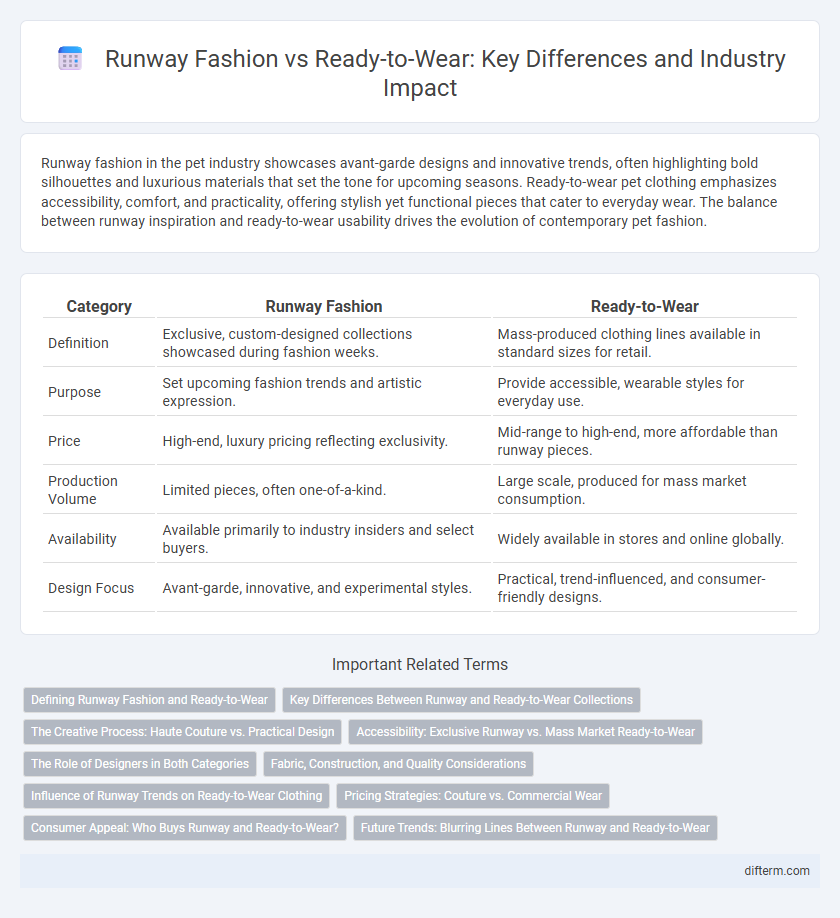Runway fashion in the pet industry showcases avant-garde designs and innovative trends, often highlighting bold silhouettes and luxurious materials that set the tone for upcoming seasons. Ready-to-wear pet clothing emphasizes accessibility, comfort, and practicality, offering stylish yet functional pieces that cater to everyday wear. The balance between runway inspiration and ready-to-wear usability drives the evolution of contemporary pet fashion.
Table of Comparison
| Category | Runway Fashion | Ready-to-Wear |
|---|---|---|
| Definition | Exclusive, custom-designed collections showcased during fashion weeks. | Mass-produced clothing lines available in standard sizes for retail. |
| Purpose | Set upcoming fashion trends and artistic expression. | Provide accessible, wearable styles for everyday use. |
| Price | High-end, luxury pricing reflecting exclusivity. | Mid-range to high-end, more affordable than runway pieces. |
| Production Volume | Limited pieces, often one-of-a-kind. | Large scale, produced for mass market consumption. |
| Availability | Available primarily to industry insiders and select buyers. | Widely available in stores and online globally. |
| Design Focus | Avant-garde, innovative, and experimental styles. | Practical, trend-influenced, and consumer-friendly designs. |
Defining Runway Fashion and Ready-to-Wear
Runway fashion epitomizes exclusive, avant-garde designs presented during fashion weeks, serving as a creative showcase for designers to set upcoming trends. Ready-to-wear, also known as pret-a-porter, consists of mass-produced garments that balance style with consumer accessibility and practicality. These collections prioritize wearability and affordability, making high fashion trends attainable for a broader audience.
Key Differences Between Runway and Ready-to-Wear Collections
Runway fashion showcases exclusive, high-concept designs often made with luxury fabrics and intricate detailing, serving as a platform for designers' artistic expression and trend-setting innovation. Ready-to-wear collections prioritize accessibility and practicality, featuring mass-produced garments that balance style with everyday wearability and affordability. The key differences lie in exclusivity, price point, production scale, and the intended consumer market.
The Creative Process: Haute Couture vs. Practical Design
Haute couture runway fashion emphasizes an intricate creative process involving hand-crafted, one-of-a-kind pieces tailored to individual clients, showcasing artistic innovation and luxury. Ready-to-wear designs prioritize practicality and mass production efficiency, balancing style with wearable functionality for a broader consumer market. The contrast highlights haute couture's focus on creativity and exclusivity versus ready-to-wear's accessibility and everyday relevance.
Accessibility: Exclusive Runway vs. Mass Market Ready-to-Wear
Runway fashion showcases exclusive, avant-garde designs typically accessible only to industry insiders and high-profile clients, emphasizing innovation and artistic expression. Ready-to-wear collections translate these high-end concepts into wearable, mass-produced garments that prioritize affordability and availability for the general consumer. This accessibility difference highlights the contrast between the exclusivity of runway pieces and the widespread market reach of ready-to-wear fashion.
The Role of Designers in Both Categories
Designers in runway fashion push creative boundaries, crafting avant-garde pieces that set seasonal trends and inspire the industry. In ready-to-wear, designers translate these high-concept ideas into practical, marketable collections that balance innovation with wearability for broader consumer access. This dual role ensures that runway shows function as a visionary platform, while ready-to-wear solidifies trend adoption in everyday fashion.
Fabric, Construction, and Quality Considerations
Runway fashion often showcases luxurious, rare fabrics like silk organza or hand-embroidered lace, emphasizing intricate construction techniques such as couture hand-stitching and elaborate draping, resulting in high-quality, exclusive garments. Ready-to-wear collections prioritize durability and accessibility, utilizing more standardized fabrics like cotton blends and polyester, combined with streamlined machine construction to balance quality with affordability. The distinction lies in runway pieces being painstakingly crafted for aesthetic impact and uniqueness, while ready-to-wear focuses on wearability and mass production standards.
Influence of Runway Trends on Ready-to-Wear Clothing
Runway fashion serves as the primary source of inspiration for ready-to-wear collections, driving seasonal trends that influence color palettes, fabric choices, and silhouettes. Designers translate avant-garde runway ideas into wearable garments, making high fashion accessible to a broader audience while maintaining the essence of innovation. This dynamic relationship accelerates trend adoption and shapes consumer demand across global fashion markets.
Pricing Strategies: Couture vs. Commercial Wear
Runway fashion employs premium pricing strategies reflecting exclusive craftsmanship, limited production, and brand prestige, targeting affluent clientele willing to invest in haute couture. Ready-to-wear collections adopt competitive pricing models designed for mass markets, balancing quality with affordability to maximize accessibility and volume sales. The stark contrast in pricing strategies underscores the differentiation between couture's exclusivity and commercial wear's market-driven approach.
Consumer Appeal: Who Buys Runway and Ready-to-Wear?
Runway fashion primarily attracts fashion insiders, celebrities, and affluent consumers seeking exclusive, avant-garde designs that set upcoming trends. Ready-to-wear appeals to a broader market, including middle-class shoppers who desire stylish, accessible, and functional garments produced in standardized sizes. The consumer appeal of ready-to-wear lies in its combination of high fashion influence with practical wearability and affordability.
Future Trends: Blurring Lines Between Runway and Ready-to-Wear
Runway fashion and ready-to-wear collections are increasingly converging as designers incorporate avant-garde elements into commercially viable pieces, reflecting consumer demand for both innovation and practicality. Digital technology and social media accelerate this fusion by enabling rapid dissemination and adaptation of runway looks into everyday wardrobes. Expect future trends to emphasize versatility, with capsule collections that seamlessly blend couture aesthetics and mass-market appeal.
Runway fashion vs ready-to-wear Infographic

 difterm.com
difterm.com